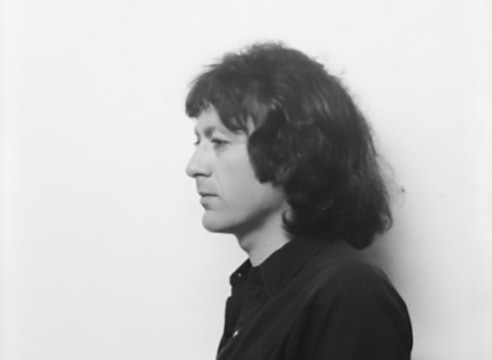
I want to turn thought into something tangible – an object – and then back to a thought.
Jack Goldstein
Interview with Morgan Fisher, 2002
Meliksetian | Briggs is pleased to present Jack Goldstein: Selectric Works. The one hundred works on paper featured in the exhibition will be shown for the first time.
A graduate assistant for John Baldessari’s first class in his Post-Studio Art program at Cal Arts in the 1970s, Goldstein (1945-2003) became best known as a key figure of the Pictures Generation, a group of artists who came to prominence in the late 1970s and early 1980s, their practice characterized by the embrace of mass media imagery and what critic and curator Douglas Crimp called the “processes of quotation, excerptation, framing and staging.”
The Selectric Works, made during a period between 1988 and 1990, are part of Goldstein’ practice of writing and making text-based works, following the production of his one-line Aphorisms and the basis of his well-known typographic portfolio, Totems. The name Selectric given to these works refers to the ‘80s era IBM electric typewriter that Goldstein used to make them, a machine characterized by its rotating type mechanism, an interchangeable ball which gave one the ability to choose various font and type styles. These works centered on 17 x 11-inch sheets of paper introduced a graphic component into his textual work.
Goldstein began making his Aphorisms in the 1970s, which began as handwritten texts pinned to his studio walls and were later typewritten on single sheets of letter size paper, as documented in a studio photograph by fellow artist James Welling in 1977. These works would be later presented as textual artworks as in the catalog of the exhibition Documenta 7 in 1992, and eventually, would be exhibited in the form of vinyl text on gallery walls. Spare and paradoxical, these single line statements were, as artist John Miller writes in a catalog from Goldstein’s 2003 exhibition at Cologne’s Galerie Bucholz, “a paradoxical manifesto…well suited for training the would-be spectator” and that “just one (Aphorism) can set out a highly condensed series of propositions that congeal into a seemly autonomous superstructure.”
The Selectric Works take significance from the fact that they expand textually upon the single line Aphorisms and while they prefigure the vertical orientation of the Totems and the use of the text itself in a pictoral manner, they resist the use of overt imagery (via Goldstein’s use of ready-made computer “clip art”) seen in that body of work. The Selectric Works have an elegant simplicity whereby the text itself – via weight, tone, spacing, various fonts and their layout – becomes almost sculptural and a sort of pictorial image in itself, as well as functioning as a proposition to the viewer. As Welling points out, “these texts are the only works Jack literally made,” his paintings, films and records being made “at a distance” by fabricators he employed. Thus “paradoxically the immediacy” of the Aphorisms, and subsequently the Selectric Works, “work against this willful distance.” The texts in the Selectric Works, some drawn from, excerpted and adapted from a variety of philosophical and literary texts, an act of appropriating and restructuring, seem familiar yet their sources are not clearly obvious or readily identifiable. However, as John Kelsey states in his 2012 essay, Goldstein’s writing “may not demand a literary sort of reading…if we do read Goldstein, it’s by staring, at a cool distance from language, as if the writing were a special effect on a silent screen.”
Jack Goldstein (1945-2003) is increasingly seen as one of the most important yet most enigmatic artists of his generation. A major survey show of his work Jack Goldstein x 10000 curated by Philipp Kaiser was presented at the Orange County Museum of Art, Newport Beach in 2012 and travelled to the Jewish Museum in New York City in 2013 (catalog). Other important solo exhibitions include a retrospective at the MMK Museum für Moderne Kunst, Frankfurt (cat.) in 2009, Le Magasin, Centre National d’Art Contemporain, Grenoble (cat.) the Whitney Museum of American Art, New York, the Luckman Gallery, Cal State, Los Angeles, and the Kunstverein in Hamburg and all in 2002, the year before his death. Goldstein’s work has recently been included in the Gwanju Biennal, Korea (2014), the 54th annual Venice Biennale (2011), Pacific Standard Time: Los Angeles Art 1945-1980, Pomona College of Art (2011), and Pictures Generation: 1974-1984 at New York’s Metropolitan Museum of Art (2009). A catalog Jack Goldstein x 10000, 2012 published by Prestel and featuring an interview between Goldstein and artist Meg Cranston is available. Special thanks to Helene Winer and Metro Pictures, New York.